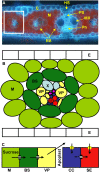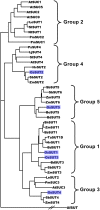Genetic control of carbon partitioning in grasses: roles of sucrose transporters and tie-dyed loci in phloem loading
- PMID: 19126697
- PMCID: PMC2613709
- DOI: 10.1104/pp.108.129049
Genetic control of carbon partitioning in grasses: roles of sucrose transporters and tie-dyed loci in phloem loading
Erratum in
- Plant Physiol. 2010 Aug;153(4):1940
Figures


References
-
- Aoki N, Hirose T, Scofield GN, Whitfeld PR, Furbank RT (2003) The sucrose transporter gene family in rice. Plant Cell Physiol 44 223–232 - PubMed
-
- Aoki N, Hirose T, Takahashi S, Ono K, Ishimaru K, Ohsugi R (1999) Molecular cloning and expression analysis of a gene for a sucrose transporter in maize (Zea mays L.). Plant Cell Physiol 40 1072–1078 - PubMed
-
- Aoki N, Scofield GN, Wang XD, Patrick JW, Offler CE, Furbank RT (2004) Expression and localisation analysis of the wheat sucrose transporter TaSUT1 in vegetative tissues. Planta 219 176–184 - PubMed
-
- Aoki N, Whitfeld P, Hoeren F, Scofield G, Newell K, Patrick J, Offler C, Clarke B, Rahman S, Furbank RT (2002) Three sucrose transporter genes are expressed in the developing grain of hexaploid wheat. Plant Mol Biol 50 453–462 - PubMed
Publication types
MeSH terms
Substances
LinkOut - more resources
Full Text Sources
Other Literature Sources
Miscellaneous

